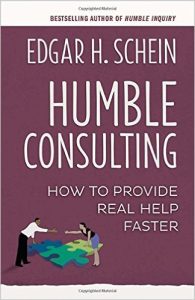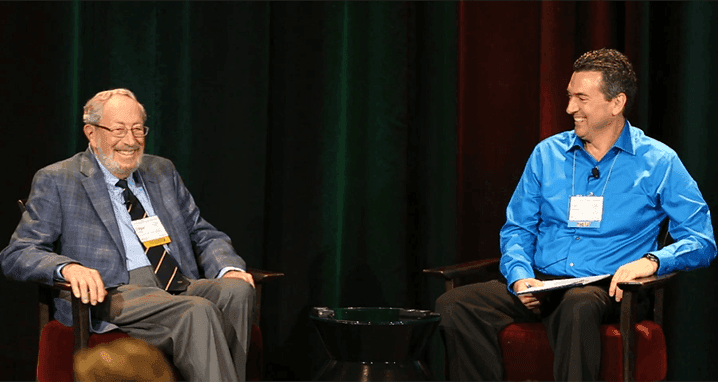Edgar Schein and the subject of organizational culture are forever linked due to his pioneering efforts in the field. His hallmark book, Organizational Culture and Leadership, has been a resource for  more than 30 years. Ed shared insights from its recently released fifth edition during an interview at the Human Synergistics Ultimate Culture Conference last fall.
more than 30 years. Ed shared insights from its recently released fifth edition during an interview at the Human Synergistics Ultimate Culture Conference last fall.
Ed explained his original motivation for the book came from things he encountered as a consultant. He shared an important example as he contrasted his work with (the now defunct) Digital Equipment Corporation (DEC) and Ciba-Geigy. DEC didn’t want him telling them how to be better at something; they wanted process help. Ciba-Geigy (now Novartis) was “the opposite”— they wanted expert advice. He wondered what was going on in these organizations.
The concept of culture DNA
“Gradually over the years, as I got more and more of this experience, I realized that there are what you might call DNA factors in the cultural genome,” he said. Ed, who has consistently warned against oversimplifying the topic of culture, said he is more interested in the DNA of the culture: “What are the things that, when we try to change cultures, turn out to be huge barriers?”
Ed explained, “We say, for example, we want a team-based organization. If you suggest to a US company that maybe, in that case, you ought to change the reward system to be team based… and make groups accountable, you get kind of a frozen look from your client.
“What’s behind that resistance? What’s behind it is that at that point, we’re not dealing with an organizational culture at all. We’re dealing with the DNA of the US culture, and the DNA of the managerial culture, which is heavily individual-accountability based.”
The importance of macro cultures
“I began to realize toward the end of the fourth edition that we’ve got to become more international, and really look at the DNA that’s embedded in the country value systems and country assumptions about how things should be.
“One of the major differences in this next edition is a great deal more emphasis on how organizations are nested in larger cultural units. A US organization is based in the US, and that may even vary in different parts of the US. A German organization is based in Germany, and what’s the role of these national cultures?”
“As culture changers, which is what most of us here (at the conference) are probably supposed to be with great difficulty, we have to learn how to deal with these national DNA factors in the very work that we do.”
Change is all about relationships
“You can’t produce changes if you don’t have a relationship with your client. Lo and behold, you discover that every society discriminates around different kinds of relationships. At one level, we have a transactional relationship: professional distance, role-related, and bureaucratic.
“In those same societies — and think in the US, for example — we know the difference between a role-related, distant, bureaucratic relationship and a personal relationship.”
Ed believes you need to decide if “you are going to treat the other individual as a total human being or just as a representative of a role.” Ed identified the transactional relationship as “Level One” and the personal relationship as “Level Two.” He argues that “one of the reasons we don’t get anywhere in our change efforts is because we’re staying at that Level One relationship.” He feel s we should be concerned about why they want a particular change and what’s worrying them.
s we should be concerned about why they want a particular change and what’s worrying them.
This theme is a continuation of insights from his recent book, Humble Consulting, “which is all about how to get into a relationship with your client so that you can uncover what’s really going on.”
“Quick and Dirty” culture assessments
Ed discussed a whole new chapter he co-wrote with his son, Peter Schein. It covers, he explained, the software-assisted “quick-and-dirty assessments to discover your culture immediately if you just take this 10-item test.”
Ed believes the DNA of our managerial culture is driving the emergence of these assessments. “The managerial culture is deeply embedded in measurement, in pragmatism, doing it fast, particularly out here in Silicon Valley.”
He encouraged change agents to understand what’s going on with the leader and why speed is so important. Find out what’s worrying them and why they won’t consider “a more intensive probe of the kind that Human Synergistics might provide.”
Push for specifics about culture
“I’m almost tempted, when I get into a client situation or a coaching situation, to say: ‘Let’s have this entire conversation without using the word culture’. Let’s see where that gets us. It forces us to be specific.
“When someone says, ‘I think we need a more constructive style,’ I say ‘What are you talking about?’ I force them to give examples that might come right out of the survey. Until we’re down at the behavioral level of what client A means by constructive behavior, I won’t know how to be helpful.”
The CEO must own the culture
“If you really are dealing with a cultural variable, like the degree to which it’s constructive, you really have to start with the CEO. You cannot change culture in the middle. Over and over again we’ve seen very effective changes in the middle or at the bottom; a new CEO comes in and says ‘What’s all this’ and changes everything overnight. That happens all the time. Therefore, if culture is really involved, the culture piece is owned by the CEO, whether he or she admits it or not.
“Those of you who are here in HR and OD and various kinds of ancillary roles, find a way to seduce your CEO into owning the culture piece. If he says to you, ‘I want a new culture, go make it happen,’ fight back immediately and say ‘Whoa, wrong conception here. We can’t make it happen. You have to make it happen, and we may be able to help you.’
What HR doesn’t understand
“But don’t try to do this on your own, because you’re too vulnerable. It may work for a while, but the CEO, and the executive suite, and the board have all the power in the world to change things overnight and undo all the good work that you may have done.
“I don’t think HR particularly understands this well enough. They have developed the notion that they really do have the power to manipulate culture. I don’t think that’s realistic. I think that can be an illusion. The CEO may say, ‘I’m all for this, go do it.’ Don’t believe him or her, because you haven’t uncovered the DNA in that person and what they will and won’t support as you go down the road.”
This post originally appeared on www.ConstructiveCulture.com
